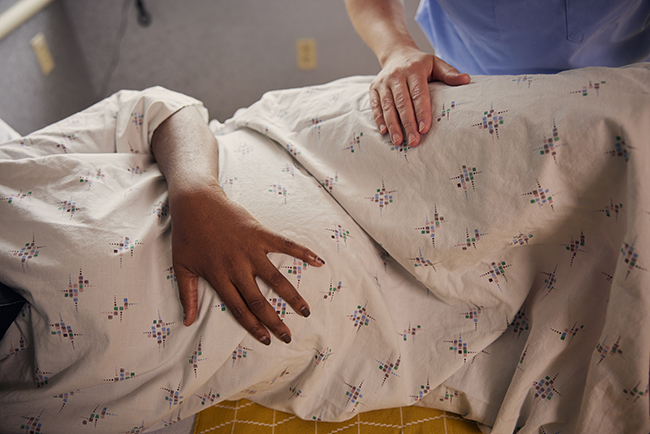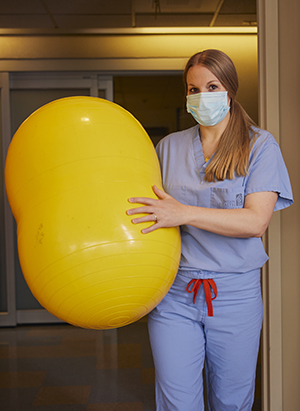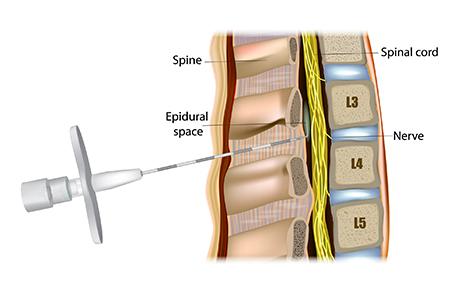Pain Relief and Anesthesiology

Labor and childbirth are different for everyone. At OHSU, you’ll find a wide range of choices to manage your pain. We offer care that is:
- Respectful. We fully support your choice to give birth with or without medication.
- Flexible. Childbirth is unpredictable. We are skilled at changing course during labor.
- Responsive. An anesthesiologist is always available and can be in your room in minutes.
Our excellence
- We have the state’s largest team of fellowship-trained obstetric anesthesiologists. These doctors specialize in relieving pain during childbirth, and team members are always in the hospital to care for you if needed. Our anesthesiologists are experts and national leaders in providing pain relief and care for people with heart, clotting and neurologic disorders during labor, delivery and recovery.
- We offer pain relief options available nowhere else in Oregon. We are the only hospital in Oregon that offers remifentanil PCA, an IV pain relief option for people who can’t have an epidural. This medication works fast and you can control how much you use.
- We are one of few hospitals nationwide that offer Programmed Intermittent Epidural Bolus. This is a way to give you maximum pain relief with less medication.
- If you prefer a birth with little or no medication, our nurse-midwives are skilled at helping you manage labor pain.
Complete care
Our doctors, nurse-midwives and nurses work as a team to tailor care to your needs. We:
Understand your birth preferences. Your birth plan is added to your chart when you check in. Your whole team uses it to guide your care.
Support your choices. We will strive to help you achieve the birth experience you hope for, whether that’s with pain-relief options or with little or no medication.
Adapt to your needs. If you change your mind or pain relief becomes necessary at any point in labor, we react quickly. An obstetric anesthesiologist — a doctor trained to give medicines that lessen or numb the pain of labor, birth and recovery — will help you in minutes.
Offer nurturing birthing suites. You can play your music, adjust the temperature, dim the lights, use comforting scents or take other steps to create a soothing environment.
Pain relief without medication
Benefits of giving birth without medication include:
- Your baby is not exposed to medication.
- No medication side effects for you or your baby.
- Labor may be shorter. Some evidence suggests that epidurals can make labor take longer.
- Some people feel a sense of accomplishment and connection to a natural process.
- You will be able to move freely during labor.

- Birthing balls and stools. You can sit on these during labor. They support you in a squat. This can be a comfortable position for pushing. You can also kneel or lie over the ball. This is helpful for back labor.
- Squat bar on your bed. You can hold onto this while squatting. If you’ve had an epidural, the bar helps you squat while you are on the bed. Squatting opens your pelvis and can help the baby move down the birth canal.
- Breathing techniques. You and your partner can learn these in our childbirth classes. Nurses and midwives can also help guide you.
- Water therapy. Many people find laboring in warm water relaxing, helping them cope with pain. You can sit in a jetted tub or take a shower.
Pain relief medications: Regional and local anesthetics
Anesthetics make you numb. They block feeling and sometimes movement in the lower part of your body. They can be used alone or along with analgesics (medications that reduce pain but don’t block feeling or movement).
Epidural
An anesthesiologist places a thin plastic tube into a space near your spinal cord in your lower back. They give you medications that block sensation and reduce pain in the lower half of your body through the tube. The tube stays in place throughout labor. This is the most common type of childbirth pain relief in the U.S.

Pros:
- An epidural provides the most effective pain relief during labor.
- It’s safe for you and your baby.
- You will be awake and alert for your baby’s birth.
Cons:
- You may be able to move your legs, but you probably won’t be able to walk.
- It can lengthen the pushing stage of labor.
- It may cause your blood pressure to drop and could slow your baby’s heart rate. To help with this, you will be given extra fluids through an IV in your arm.
- You may have a catheter (thin flexible tube) for urinating.
- You could get itchy, develop a fever or be sore at the injection site.
- The medications can take 15 to 40 minutes to take effect.
- About one in 100 people get a bad headache.
- Serious complications are rare. They include breathing problems and nerve damage.
After we place the epidural tube in your lower back, we give you a handset attached to a pump. You can press a button to release medication. We program the pump so you can’t get too much.
Pros: People who control their own epidural often use less medication than they would receive with a standard epidural. They may also feel more in control of their pain relief.
Cons: These are the same as for a standard epidural.
This is a single injection of medicine into the spinal fluid in your lower back. It quickly makes the lower part of your body numb, but you stay awake and alert. It is often used to block pain during a C-section.
Pros and cons: A spinal block relieves pain much faster than an epidural, but lasts only one or two hours. Other risks and benefits are the same as for a standard epidural.
A spinal block to numb you quickly is combined with an epidural to give you continuous pain relief. We can use lower doses if you are giving birth vaginally and want to be able to move a little. We often use higher-dose combined spinal-epidural blocks during a C-section.
Pros: Combined spinal epidural blocks provide faster pain relief than standard epidurals and longer pain relief than spinal blocks.
We inject pain-blocking medication in your vaginal area or perineum (the area between your vagina and anus). We may do this just before delivery if we need to use forceps, suction or an episiotomy (a cut to enlarge the vaginal opening) to help your baby be born.
We also use a pudendal block or local anesthetic injection after delivery if you need stitches to repair tears.
Pros:
- It lessens pain for up to an hour.
- Side-effects for the baby are rare.
Cons:
- It may numb pain in only part of the perineum.
- It could cause an allergic reaction.
- In rare cases, it could cause an infection.
- Injecting the medicine into a vein might affect the mother’s heart or central nervous system.
Pain relief medications: Analgesics
Analgesics are opioids and other medicines that reduce pain but don’t make you numb or affect how you move.
A mild pain reliever that helps you relax and feel less anxious. You breathe it in through a mask or mouthpiece, before a contraction.
Pros:
- It can help you cope with pain.
- It is safe for you and your baby.
- You decide when and how to use it.
Cons:
- It’s not a strong pain reliever and won’t take away all your pain.
- It can cause dizziness, nausea and vomiting.
- It may take practice to get the timing right.
These pain relievers are usually given in a shot or IV.
Pros:
- They can make you feel relaxed.
- They can lessen your pain without numbing you or affecting your ability to move.
Cons:
- They don’t take away all your pain. They are not as effective as epidurals.
- They can cause nausea, vomiting, drowsiness and itching.
- They can affect your baby’s breathing and heart rate for a short time.
- They can make your baby sleepy.
This may be a good option if an epidural or spinal is not safe for you. Remifentanil is an opioid that provides fast, strong pain relief. You press a button connected to a pump and IV to deliver a dose into your bloodstream. OHSU is the only hospital in Oregon to offer this form of pain relief.
Pros:
- It provides effective pain relief if you have a spinal, neurologic or bleeding disorder that means you can’t have an epidural.
- Unlike other opioids, it doesn’t make your baby sleepy.
Cons:
- It takes away pain for just a few minutes per dose. You don’t get the ongoing pain relief of an epidural.
- It can slow down your breathing, so we will monitor you closely.
Pain relief for C-section births
A surgical delivery is necessary when a vaginal birth would put you or your baby at risk. Our experienced obstetric anesthesiologists are skilled at blocking pain, keeping you awake, and keeping you and your baby safe during a C-section. We are always ready for any kind of C-section — scheduled, unplanned or emergency.
For most C-sections, we offer the same pain relief options as for vaginal births. You stay awake. We use medication that takes away pain and sensation in your lower body. You might feel some pressure or tugging. Pain relief lasts through and after the surgery.
Options include:
- A spinal block: The anesthesiologist injects numbing medication into your spinal fluid. It works fast.
- An epidural: The anesthesiologist puts a thin plastic tube in a space near your spinal cord. Medication to block pain goes through the tube as needed. It takes longer to numb you than a spinal block.
- A combined spinal-epidural block: The spinal numbs you quickly for surgery. The epidural increases your medication if needed.
Chloroprocaine lavage: In rare cases, regional anesthetics don’t provide enough pain relief during surgery. This new technique provides pain relief during surgery without general anesthesia so you can stay awake for the birth of your baby.
OHSU was the first hospital in the U.S. to publish studies of chloroprocaine lavage. We have the most experience in this technique that is now used around the country.
The method involves splashing the abdominal organs with chloroprocaine. This numbing medicine takes away breakthrough pain and doesn’t have bad side effects for you or your baby.
This is rarely used. It’s only for some emergencies or if you can’t have regional anesthesia. The anesthesiologist puts you to sleep while a skilled team does the surgery. You are not awake for the birth of your baby.
Most people use opioids. We offer non-opioid options for people who have been addicted to narcotics or have some types of chronic pain. These include walking epidurals and IV ketamine or lidocaine.
Learn more
- What are the options for pain relief during labor and delivery? National Institutes of Health
- Medications for Pain Relief During Labor and Delivery, American College of Obstetricians and Gynecologists
For patients
- Labor and delivery: 503-494-7534
- Prenatal care: 503-418-4500
Location
Parking is free for patients and their visitors.
OHSU Hospital
3181 S.W. Sam Jackson Park Rd.
Portland, OR 97239
Driving directions
Baby Steps
A weekly guide to pregnancy and your child’s early development.
Safety resources
Get safety tips and advice from Doernbecher’s Tom Sargent Safety Center.